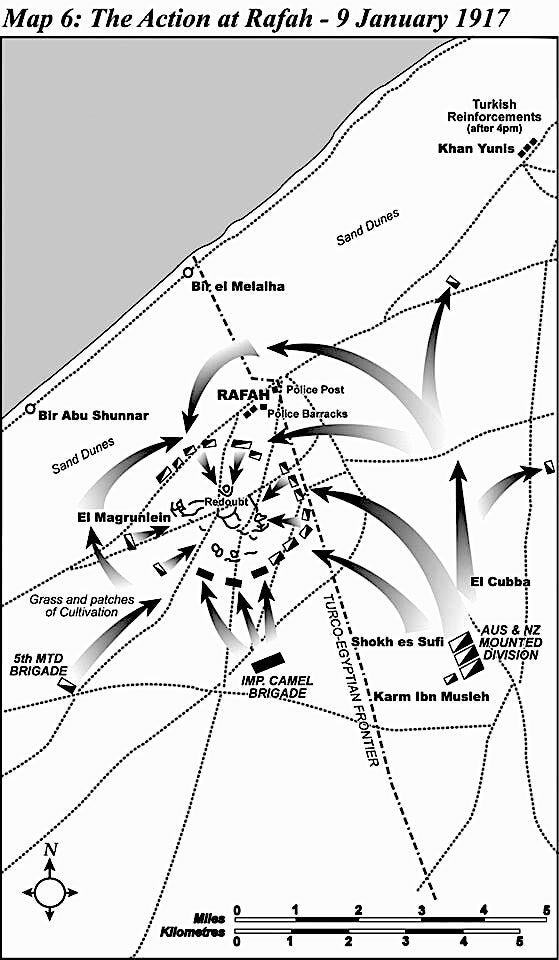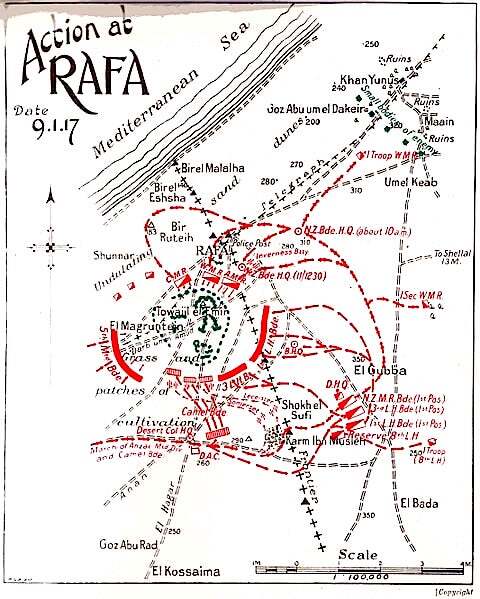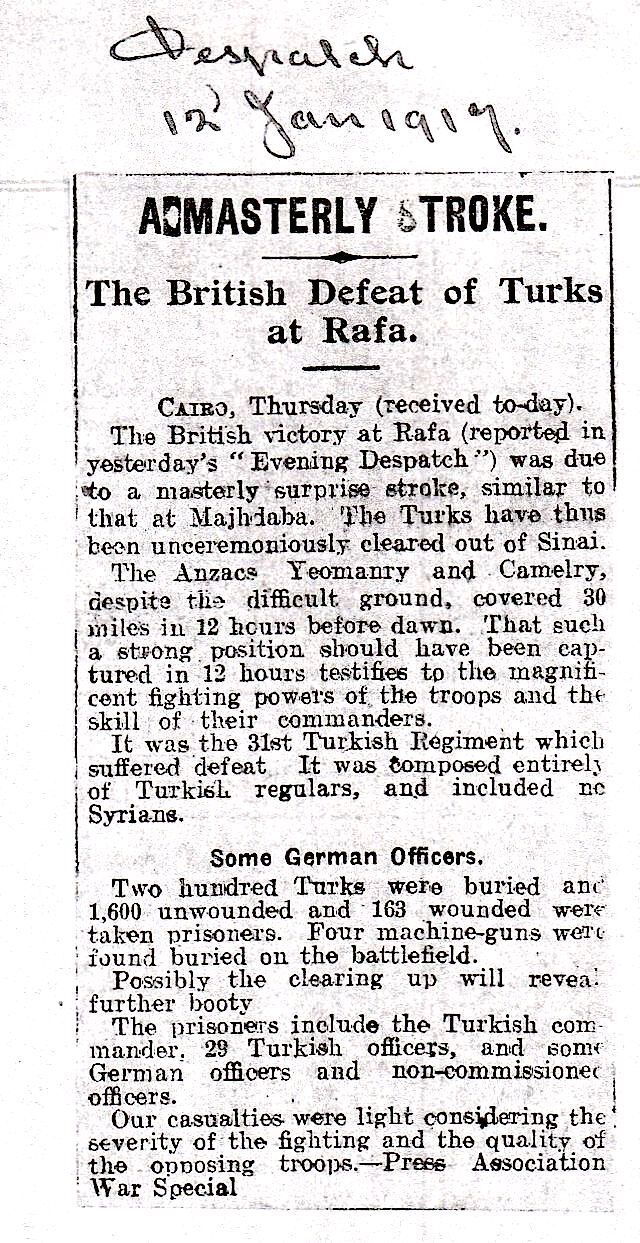The Warwickshire Yeomanry 1917
Part 1: Battle of Rafa (Rafah) 9th January 1917.
At 4pm on 8 January 1917 the 5th Mounted Brigade marched eastward from El Arish with the Desert Mounted Column, including the Anzac Mounted Division and the Camel Corps to attack the entrenched position held by the enemy at a point west of Rafa (Rafah). The Brigade acted as advance guard and camped for the night at Sheik Zowaid.
At 1am on the 9 January they continued the advance towards the Turkish entrenchments as the enemy slept. The Warwickshire Yeomanry in half Squadrons extended, moved down the Rafa Road at the trot with the Gloucestershire Yeomanry on its left flank across 2.5 miles of open plain commanded by the Turkish redoubt, being forced to dismount for action within 2,000 yards of the foot of the redoubt. Meanwhile the New Zealand Mounted Division made an enveloping attack from the east, the Australians and Camel Corps from the Southeast and South. The Yeomanry were ordered to attack from the West. Large bodies of Light Horse and Yeomanry galloped into action supported by artillery.
By 5.30pm all organised resistance was over and the enemy's position with its garrison was captured. For further details see ‘The Warwickshire Yeomanry in the Great War’ by ADDERLEY, published in 1922.

The Warwickshire Yeomanry 1917
Part 2. Battle of Rafa (Rafah) 9th January 1917.
The Warwickshire Yeomanry War Diary for the Battle of Rafah provides a useful summary, much of which can be found in ADDERLEY’s ‘The Warwickshire Yeomanry in the Great War.‘
The Warwickshire Yeomanry left El-Arish at 4pm on the 8th January 1917: 26 Officers, 379 ORS, 422 Horses and 18 pack animals, as part of the 5th Mounted Brigade.
2274 Pte Phillip CAMPION in ‘CAMPION’S WAR - Being the experiences of a Warwickshire Yeoman 1914-18’ provides the following account for the Battle of Rafah:
‘The Cavalry was massed on a plain outside El-Arish and then started the first twenty-seven miles march. All night we travelled at walking pace until the early hours of the morning, when each regiment took up its position from which to advance at a given signal. The Colonials went round the back of the hill, the Camel Corps to the south and the Yeomanry west. No one enjoys the waiting part of these adventures; we were glad when the order came to get mounted. We advanced in two extended lines fifty yards apart. All went very nicely for a while, then we came within range of the Turk’s guns, machine guns and rifles, and the bullets started whistling an unpleasant tune in our ears. Any further attempt to advance on horseback would have been useless, so we were ordered to dismount. One man is left in charge of four horses, which were taken behind a hill for cover.
The serious business now began in earnest, our line of advance lay across a grassy plain, with absolutely no cover. We lay down and let them have it for all we were worth, then advanced by fifty yards, rushed and started pelting them again. Our artillery had got into position and were sending over salvo after salvo into the Turks’ position. But the Turk is a good fighter in trenches and all the time we were paying heavily in killed and wounded. One couldn’t see one’s neighbour in the line for the dust and smoke, the lead came down in showers. As the day wore on, those who were left gradually got nearer to the enemy, but we had to slow down the firing as ammunition was getting short. We saved about five rounds for the final assault, then at about 3 or 4 o’clock we suddenly had the order to retire to our horses and ride to the Gloucestershire Yeomanry assistance on our left, as from there the Turks’ trenches were more accessible. But it seemed the task would be too much, and at 5 o’clock Sir Philip CHETWODE had given the order to retire all along the line, when the Colonials with a final rush got amongst the Turks with the bayonets and soon the white flag was flying from the hill.’
Philip CAMPION records he was ‘tired out, no sleep for thirty-six hours, a gruelling day and twenty-seven miles ride through the night ahead of us’ back to El-Arish. Little wonder that he fell asleep in the saddle once or twice on the return journey, as did others.
The Warwickshire Yeomanry War Diary records casualties for 9th January 1917 as follows: 2 Officers wounded, 3 ORS killed in action, 36 ORs wounded of which 2 subsequently died of their wounds, 6 horses killed, and 45 horses wounded.

The Warwickshire Yeomanry 1917
Part 3. Battle of Rafa (Rafah) 10th January 1917.
The columns staggered into El Arish throughout the morning, to be met by volunteers of the 52nd (Lowland) Division, who turned out to guide them in and to pump water for their horses, a gesture that was greatly appreciated. Back at El Magruntein, though, the work went on. Soon after dawn on 10 January, a light skirmish was fought between the 8th ALH Regiment and the Ottoman reinforcements, who soon retreated once it was confirmed that the garrison had fallen.
The Field Ambulances had worked all night to collect the scattered wounded in the darkness. At least one, the 5th Mounted Brigade, had lit a beacon at their position, to help guide the stretcher bearers into the right place. It was not until nearly noon that the work was finally completed, and the last ambulance (and escort) began the long march back to El Arish.
Patrick Hamilton’s unit did not arrive there until late in the evening:
“We collected all our own Brigade wounded and moved them back a few miles to the 1st LH Field Ambulance Casualty Clearing Station, temporarily established for the purpose, by about 4 a.m. on 10 January. We buried nine who had died of wounds. After the wounded had been redressed and fed, we loaded up the sand carts again and travelled steadily back some 20 miles to the Anzac Casualty Clearing Station at El Arish which we reached by about 9 p.m. There we cleared our wounded and returned to our own camp to turn in about 1 a.m. on January 11, after 65 hours without any sleep – except once when I fell off my horse asleep and woke up on the ground!” [Hamilton, ‘Riders of Destiny’, p.18.]
Although the British had withdrawn, the Ottomans did not reoccupy Rafah. They had finally learned that isolated garrisons were, while no easy pickings, still far too vulnerable to attack by the British mounted forces. With their withdrawal back to Khan Yunis, Shallel, Gaza and Beersheba, the Ottomans had ceded the Sinai Peninsula and for the first time adopted a purely defensive posture. For the British, Egypt was finally secured. Now all that remained would be to push the Ottomans out of Palestine too.
Image: Imperial Camel Corps on the march

The casualties in the Warwickshire Yeomanry for the Battle of Rafah 9th January 1917 are as follows: Killed in action: Cpl H. HANDS, Shoeing Smith, Pte T. TAYLOR, and Pte W. TYACKE. Died of wounds: L/Sergt P. GIBNEY and Pte T. NORTHOVER. Capt. E.G. PEMBERTON and 2nd Lieut K. WARE were wounded (the latter dangerously) and some 32 Other Ranks whose names are recorded in the List of Casualties which can be found in ADDERLEY's 'The Warwickshire Yeomanry in the Great War.'
The Warwickshire Yeomanry 1917
11th January to 26th March 1917.
Enclosed are copies of two original newspaper reports covering the action at Rafah from the ‘Despatch’ and ‘Gazette’ published on 12th January 1917. We have more in our archives which can be viewed upon request.
ADDERLEY records that ‘the Victory at Rafah on 9 January 1917 greatly cheered the men after so many months of desert trekking, and outpost work; and all were in the best of spirits. The next fortnight was occupied in friendly Staff rides and Regimental drills varied with an occasional jackal hunt over the surrounding flat country.’


El Burj was the next camp, 8 miles from El Arish further north and 2.5 miles from the sea, a spot where a few shumac and olive bushes relieved the monotony of the desert, and the undulating sand hills afforded some protection. Six weeks were spent there and during that time six Officers with reinforcements joined the Regiment. The Worcestershire Yeomanry and Gloucestershire Yeomanry were in camp within a mile and the whole Brigade were together on 1st February 1917.
The Camp at El Burj was on the old caravan route from the Suez Canal via Rafah and Gaza into Syria, and good football and polo grounds were available. It was the Brigade’s duty to trek daily to positions out at Sheikh Zowaiid, each Regiment taking their turn every third day. Horses were watered on the beach, about 2 miles across the dunes, as good fresh water was obtainable along the coast at 5 to 15 feet depth. At night outpost pickets were stationed on the highest sand hills.
The very successful action at Rafah on 9 January 1917 had brought the scene of operations to the boundary of Palestine, Gaza was now the immediate objective. Sir A. MURRAY describes how the operations to this point had been entirely dependent on the military railway which had been built across the sandy coastal tracks of the Sinai Peninsula from the Suez Canal. By the middle of March 1917 this line had reached Rafa (Rafah) – 20 miles from Gaza and 35 miles from Beersheba – the Turkish left flank. It was evident that the enemy intended to withdraw from the Gaza- Beersheba line, and this was considered important to prevent, it being also necessary to seize the intervening line of the Wadi Ghuzze. These two enterprises were the objects of the Battle of Gaza, the third being the capture of Gaza and the cutting off of the Turkish Garrison. The first two objects were attained but the third which commenced on the 26 March 1917 failed.
On 21 March 1917 the 5th Mounted Brigade trekked to a camp at Rafah and for the first time crossed the Sinai-Palestine border. Here the first ‘Grand Palestine Race’ Meeting took place on the spot where some weeks before the battle had been fought and won. The prize for the ‘Sinai Grand National’ was won by Captain GOOCH, Warwickshire Yeomanry riding his own horse ‘Clautoi.’ This horse had a remarkable career having survived the torpedoed ’Wayfarer’ and was wounded for the third time on ground where he won the 2.5 mile steeplechase a few weeks later. In March 1918 ‘Clautoi’ won a further two races on the plains of Gaza.